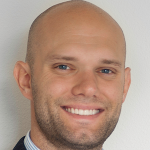Sebastian Purcell is an award-winning associate professor of philosophy at SUNY-Cortland in New York. He researches ethics, Aztec philosophy, and mathematical logic.
What’s the big idea?
While traditions like Buddhism and Stoicism teach you to go inward—to still your mind through meditation and journaling—the Aztecs taught the opposite. Your mind, they believed, is easier to steady if you start with your surroundings: your environment, your habits, your relationships. You take the outward path.
Below, Sebastian shares five key insights from his new book, The Outward Path: The Wisdom of the Aztecs. Listen to the audio version—read by Sebastian himself—below, or in the Next Big Idea App.
1. You aren’t really after happiness; you just think that you are.
The Florentine Codex contains this striking passage from a father to his daughter:
My daughter, my child, hear well: the earth is not a good place. It is not simply a place of happiness or joy. It is said only that the earth is a place of happiness-fatigue, happiness-pain ….
The word used for “happiness” in this passage is paqui, which means to experience pleasure and enjoy oneself. It’s happiness in the bare sense of the term, mere elevated emotional states. And the father is telling his daughter that you can’t ever experience that without coming back down to a different state, such as fatigue or pain.
Western traditions, by contrast, often elevate happiness as the ultimate goal. It’s in the Declaration of Independence. Aristotle wrote volumes about it. But the Aztecs would say: that can’t be right. Chasing happiness makes as much sense as trying to grow seven feet tall. It’s simply not the kind of thing you can control.
If you prefer the term “happiness,” then keep it, but you really mean some richer, more encompassing value. The Aztecs used a number of metaphors to refer to this goal, and since many of these metaphors involved turning on trees with deep roots, standing on one’s feet, or living well with one’s community, I think the best word in English for this constellation is “rootedness.” You’re after a life well-rooted in your body, your psyche, society, and the natural environment.
2. The wise don’t think for themselves.
If your goals are clear, you’ll realize that you didn’t come to them alone. You read, listened, asked questions, argued, and (hopefully) changed your mind. You thought with others. That’s why the Aztecs treated decision-making as one of the paradigm external practices. Good judgment wasn’t a solo achievement; it was a group project.
“You read, listened, asked questions, argued, and (hopefully) changed your mind.”
In one passage, recorded in the Florentine Codex, a group of merchants gather to discuss travel to another town. The text reads:
And when [the host] had thus spoken to them, then the principal merchants of all the neighborhoods … responded to his words. … [And] they sat in order by rank. At one side, by the wall on the right, were the principal merchants; and on the other side, starting on the left, sat the other sorts of merchants …. Capping the ends were the youths.
Everyone has a voice, even the young, but those with experience are listened to more carefully. This organizational structure allows for tested wisdom to rise to the top.
Today, we can model this by forming what I call an “Aztec decision circle.” Ask yourself: Who do I turn to for advice? On what topics? Do they have a strong track record? Are there enough dissenting voices? What perspectives are missing?
My students typically realize they haven’t built such a circle at all. That realization alone is progress. But insight isn’t enough. Acting on decisions, especially good ones, requires willpower.
3. Willpower is three things.
A paradox I first noticed in graduate school was this: I could study philosophy for ten hours a day without flinching, but if you left a sleeve of Oreos in the house, I’d eat all of them before noon. I was somehow both disciplined and undisciplined, which is not a great look, especially in a field that prides itself on logic.
The Aztecs would have recognized this pattern immediately. Their practices show that they addressed willpower in three forms:
- Drive (high-intensity action)
- Durability (consistent effort)
- Discipline (resistance to temptation)
Running into a flooded basement to salvage your belongings? That’s Drive. Saying no to cake at midnight? That’s Discipline. Studying daily for months? Durability. They’re all forms of willpower, but they require different “muscles,” so to speak.
The Aztec solution is to train all three. You need different tools for different challenges. They built rituals around this, including tasks at dawn, fasting, and physical hardship such as carrying heavy logs. These were conceived not as punishments, but as diagnostics. By participating in them, you find out what you’re made of, and more importantly, where you tend to fall apart.
4. What crosses your lips pre-frames your mind.
External practices, such as the Aztec decision circle, need to be complemented by liminal practices. These are activities that focus on something that stands at the threshold of your consciousness. A paradigm example is Right Speech, as our words can be consciously selected, but we typically don’t know how we’ll end a sentence as we begin it.
In volume six of the Florentine Codex, a mother tells her daughter to speak in such a way as to preserve her traditional words of wisdom “in the chambers of your heart” (FC 6.19, 99). Right Speech for the Aztecs is a practice meant to conserve what is good and upstanding about you at your core. Without a sense of what is good in life, you cannot distinguish Right Speech from drivel.
In another discourse, a few chapters later, a father advises his son on how to be prudent in public conduct. A key practice is Right Speech. This includes remaining humble in his demeanor and being true with others. Moreover, he advises:
You are to speak slowly and deliberately. … [And] guard, take care of your ears, of what you hear. Do not gossip.
In short, Aztec Right Speech, intended to protect and promote what is good about your personality, has four characteristics:
- Speak thoughtfully
- Speak truly
- Speak humbly
- Don’t gossip
Notice how the focus isn’t on bad words or blasphemy. The goal with Right Speech is to achieve alignment between your goals and your thoughts. There is some contemporary research to suggest the Aztecs were onto something.
The psychologist Robert Cialdini relates a story that changed his mind about the impact of small words. He was invited to give a talk at SSM Health, a non-profit in the medical industry renowned for its stratospheric performance. Yet he was told that in his presentation, he would have to replace specific words:
- Instead of “bullet points,” say “talking points.”
- Instead of “attacking a problem,” say “approaching a problem.”
- Instead of “beat the competition,” say “outdistance the competition.”
Befuddled, Cialdini asked: Why would such small words matter? The answer, he discovered, is that what crosses your lips pre-frames your mind. If thoughts lead to actions, then words inconsistent with your goals will lead to actions inconsistent with your goals.
After contact with the group and researching the topic himself, Cialdini stated his new view bluntly:
I’m a convert now. My response to SSM’s strict language policy transformed from “Geez, this is silly” to “Geez, this is smart.”
In SSM Health’s case, their goal is to improve people’s lives through healing. Violent language is inconsistent with that goal. So, they eliminated as much of it as they could.
Right Speech stands at the threshold of external and internal activities. To move further inward, you might practice meditation, teomania, as the Aztecs called it. But these four insights give rise to a fifth, which is intended to highlight the value of this outward path more broadly.
5. Why the wise follow the outward path.
The Florentine Codex presents a passage describing the activities of the learned ones, the philosophers. They are said to hold up a mirror to an interlocutor, allowing them to know themselves to some greater degree of precision. The Aztecs thought this activity was worthwhile, but how valuable, exactly? Hard to say. Philosophy doesn’t give you money or medals. But I think a story can clarify its worth.
“They are said to hold up a mirror to an interlocutor, allowing them to know themselves to some greater degree of precision.”
Viktor Frankl, the Holocaust survivor and psychiatrist of the bestselling Man’s Search for Meaning, once worked with a client who seemed to be practicing an Aztec goal exercise. An elderly doctor came into Frankl’s office and shared that he had been inconsolable for two years after his wife’s death. Frankl asked him if his wife would have mourned his loss had he died first. The man said she would have been equally distraught.
Whereupon I replied, “You see, Doctor, such suffering has been spared her, and it was you who have spared her this suffering—to be sure, at the price that now you have to survive and mourn her.”
The man said nothing in reply, but calmly shook Frankl’s hand and left. He had been “cured” after only five minutes by reframing his suffering as something meaningful.
What would you pay to move from sorrow to tranquility? Is it worth $10,000? $100,000? More? Philosophy’s value lies precisely here, in the intangibles. In its ability to reframe what seemed unbearable into something purposeful. The Aztecs’ outward path doesn’t negate inner stillness. It simply shows a different way to reach it: through action, ritual, and community. If that gets you a little closer to being rooted—in yourself, in your goals, in the world—then it has done exactly what it was meant to do.
Enjoy our full library of Book Bites—read by the authors!—in the Next Big Idea App:










